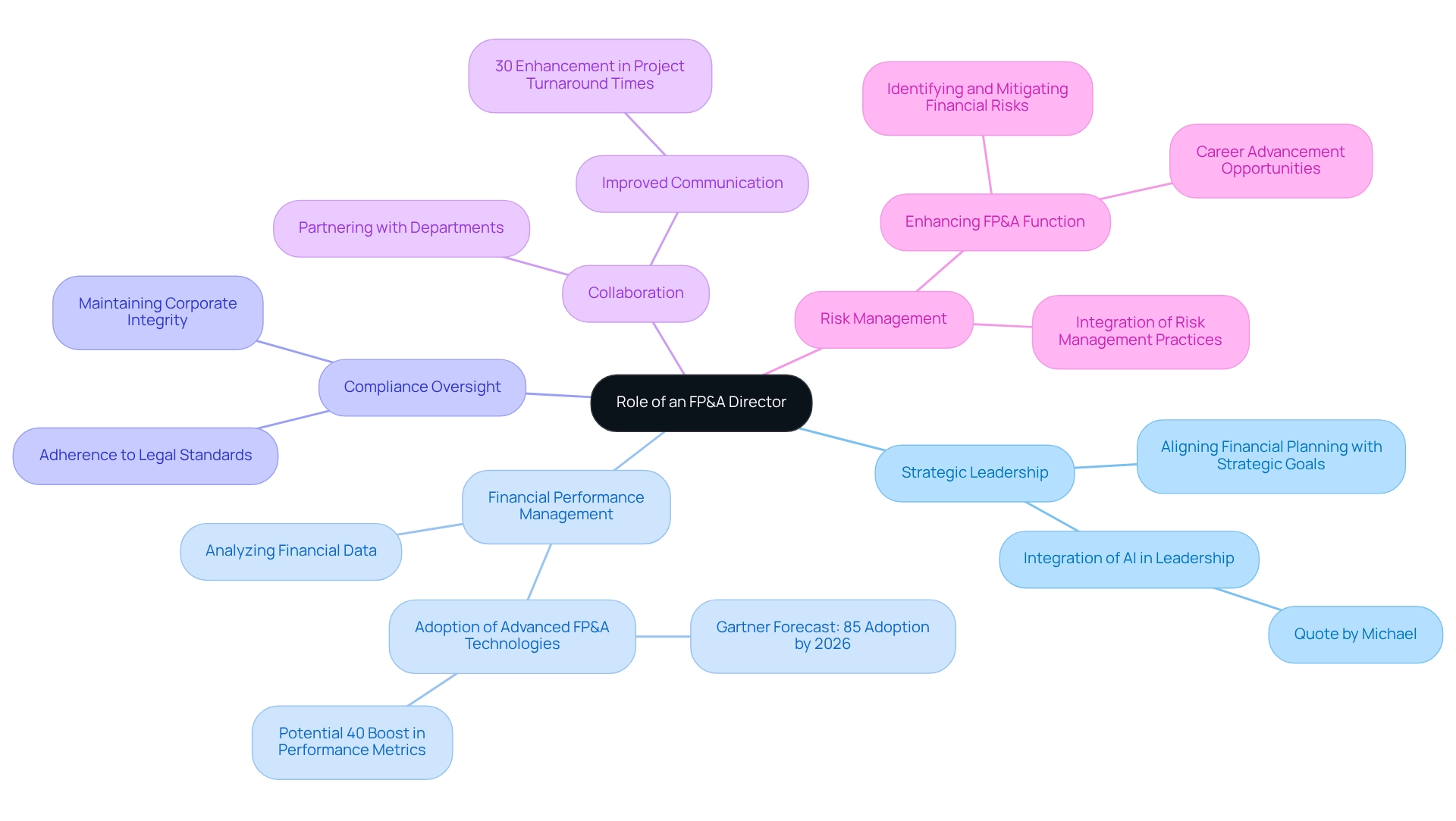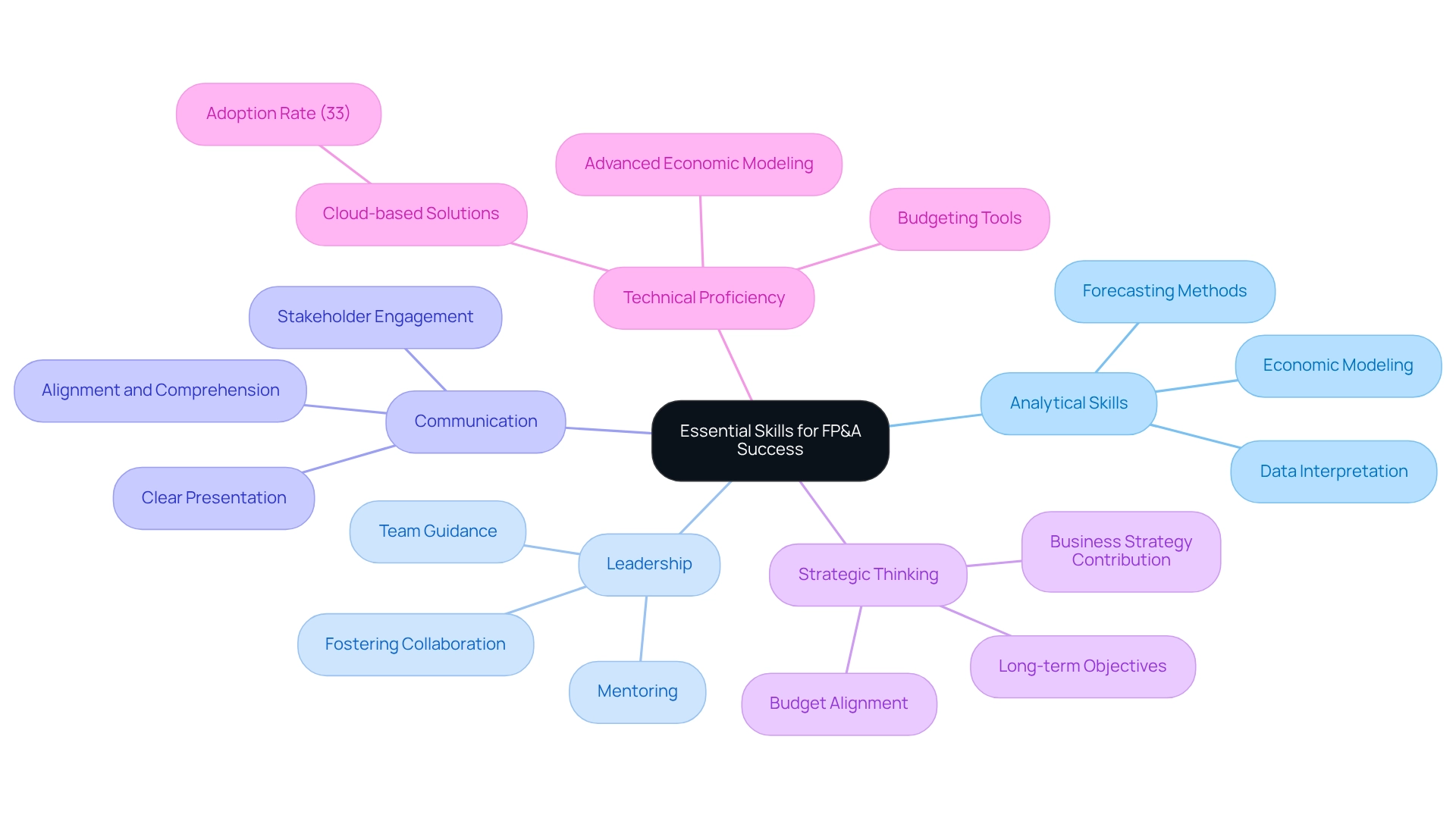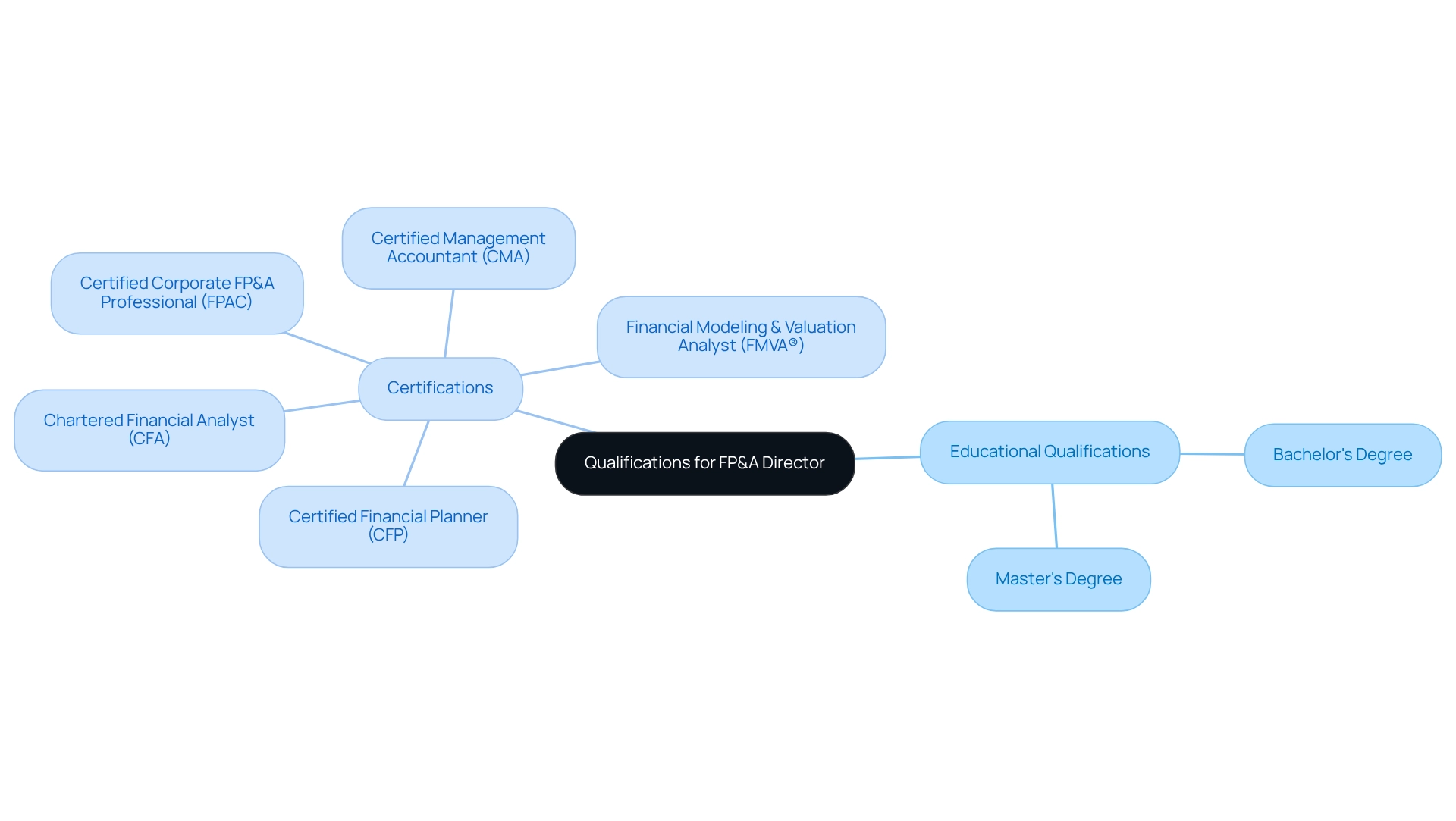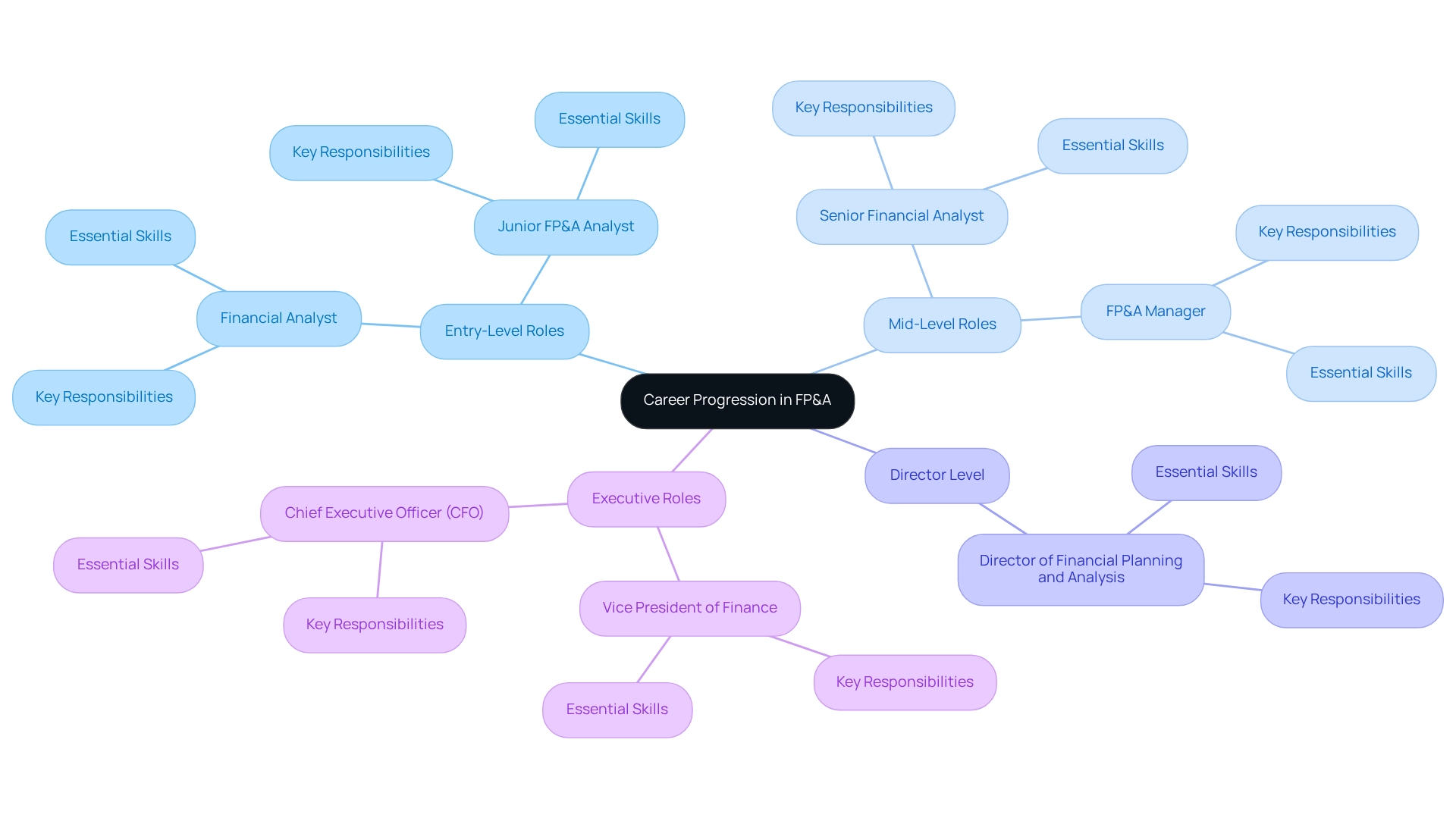Overview
The role of a Director of Financial Planning and Analysis (FP&A) is paramount in steering an organization’s economic strategy. This position ensures that financial performance is not only aligned with organizational goals but also leverages advanced technologies to drive improved outcomes. The article elaborates on the director’s critical responsibilities, essential skills, and the significance of education and certifications. These elements are indispensable for navigating the complexities of financial leadership and achieving career advancement within the FP&A realm.
Key Highlights:
- The FP&A Director is essential for guiding economic strategy and ensuring financial performance aligns with organizational goals.
- Key responsibilities include strategic leadership, financial performance management, compliance oversight, and collaboration across departments.
- Adoption of advanced FP&A technologies is expected to improve financial performance metrics significantly by 2026.
- Critical skills for FP&A success include analytical skills, leadership, communication, strategic thinking, and technical proficiency.
- Relevant education includes a bachelor’s degree in finance or accounting, with advanced degrees and certifications enhancing career prospects.
- Professional certifications such as CFA, CMA, and FPAC can distinguish candidates in the job market and are linked to career advancement.
- Career progression typically starts from entry-level roles to director and executive positions, with an average transition time of 5 to 7 years.
- Networking and continuous learning are vital for advancing in the FP&A field, alongside a focus on data management and ownership.
Introduction
In the dynamic world of finance, the role of the Director of Financial Planning and Analysis (FP&A) has emerged as a cornerstone of strategic leadership within organizations. This pivotal position demands not only a keen understanding of financial performance and compliance but also the ability to steer the company toward growth and profitability in an ever-evolving landscape.
As the business environment becomes increasingly complex, the integration of advanced technologies and risk management practices has transformed the expectations placed on FP&A leaders. From mastering analytical skills to pursuing relevant education and certifications, aspiring FP&A Directors must equip themselves with a diverse skill set to navigate their career progression effectively.
Understanding the multifaceted nature of this role is essential for those looking to make a significant impact in the financial domain.
Understand the Role of an FP&A Director
The role of the director of financial planning and analysis is pivotal to an organization’s success, providing essential leadership in economic strategy. This position encompasses the oversight of economic performance, adherence to regulatory standards, and support for the company’s growth and profitability objectives. Key responsibilities include:
- Strategic Leadership: Directing the financial planning process to align with the organization’s overarching strategic goals, thereby enhancing decision-making capabilities. As Michael observed, “As AI becomes integrated into everyday tools, this barrier is diminishing,” emphasizing the significance of technology in contemporary leadership within the economy.
- Financial Performance Management: Analyzing financial data to evaluate performance metrics and pinpoint areas for improvement is crucial in a competitive landscape. Gartner forecasts that over 85% of companies will adopt advanced FP&A technologies by 2026, potentially boosting financial performance metrics by up to 40%. This adoption aligns with the director of financial planning and analysis’s responsibility to utilize technology for competitive advantage.
- Compliance Oversight: Ensuring adherence to legal and regulatory standards is vital for maintaining corporate integrity and trust.
- Collaboration: Partnering with various departments to provide insights that guide business decisions enhances overall organizational effectiveness. Improved communication within FP&A teams has been shown to increase project turnaround times by 30%, underscoring the importance of collaboration. This statistic illustrates how effective teamwork can lead to significant operational improvements.
The integration of risk management practices within FP&A is increasingly essential as organizations navigate uncertain business environments. According to the case study titled ‘Risk Management in FP&A,’ this strategic focus not only improves the function of FP&A teams in identifying and reducing financial risks but also creates opportunities for career growth. Understanding these responsibilities is essential for anyone aiming to excel as a director of financial planning and analysis, as it highlights the multifaceted nature of FP&A leadership and its influence on business growth.
Develop Essential Skills for FP&A Success
To excel as a Director of Financial Planning and Analysis (FP&A), a blend of technical and soft skills is indispensable. The following skills are vital for success in this role:
- Analytical Skills: The capacity to interpret complex financial data and derive actionable insights is paramount. Mastering economic modeling and forecasting methods is essential, as these abilities directly influence decision-making and business planning. A case study on monetary modeling and forecasting underscores how these skills provide insights for tactical decision-making, highlighting their significance in the role.
- Leadership: Effective leadership encompasses guiding and mentoring a team while fostering a collaborative environment that promotes innovation and accountability.
- Communication: Strong communication abilities are critical for presenting economic information clearly and persuasively to stakeholders at all levels, ensuring alignment and comprehension throughout the organization.
- Strategic Thinking: Aligning budget planning with the organization’s long-term objectives necessitates a strategic mindset, empowering the FP&A Director to contribute meaningfully to the overall business strategy.
- Technical Proficiency: Familiarity with advanced economic modeling, budgeting, and forecasting tools is essential, particularly as 33% of companies have embraced cloud-based FP&A solutions. This trend reflects a significant shift in monetary planning practices, necessitating that the Director of Financial Planning and Analysis adapt their skills accordingly.
Investing in the cultivation of these skills not only enhances efficiency in the position but also equips professionals to navigate the evolving challenges of the economic landscape. As noted by Paul Barnhurst, an experienced finance expert, “Best Practices FP&A is a comprehensive course that emphasizes the importance of continuous enhancement in analytical skills for finance professionals aiming to implement impactful monetary strategies.
Pursue Relevant Education and Certifications
To enhance your candidacy for the FP&A Director role, pursuing relevant educational qualifications and certifications is essential. Consider the following:
- Bachelor’s Degree: A foundational degree in finance, accounting, or a related discipline is typically required for this role.
- Master’s Degree: An MBA or a Master’s in Finance can significantly elevate your competitive advantage, equipping you with advanced skills in analysis and strategic decision-making.
- Certifications: Earning professional certifications can further distinguish you in the job market. Consider pursuing:
- Certified Financial Planner (CFP)
- Chartered Financial Analyst (CFA)
- Certified Management Accountant (CMA)
- Certified Corporate FP&A Professional (FPAC)
- Financial Modeling & Valuation Analyst (FMVA®)
These credentials not only deepen your financial knowledge but also convey to employers your dedication to professional excellence. The Bureau of Labor Statistics forecasts a 16% increase in the FP&A Director position through 2032, highlighting the rising need for qualified professionals in this field. Moreover, certifications are linked to enhanced career advancement opportunities, making them a valuable investment in your future.
As organizations prepare for 2025, the integration of advanced financial tools and a focus on data-driven decision-making will further elevate the importance of these qualifications in the FP&A landscape. As Chad Martin, CFO, aptly stated, “Listen to all the voices in the room. Because sometimes, the strongest and best advice is delivered in a whisper, not in a shout.” This underscores the collaborative aspect of FP&A, emphasizing the need for continuous learning and adaptation.
Navigate Career Progression and Advancement Opportunities
Career advancement in the Planning and Analysis (FP&A) sector typically follows a clearly defined path, essential for those aspiring to leadership roles. Consider this roadmap:
- Entry-Level Roles: Start your career as a Financial Analyst or Junior FP&A Analyst. These positions provide vital foundational experience in data analysis, modeling, and reporting—skills that are crucial for future success.
- Mid-Level Roles: Move up to Senior Financial Analyst or FP&A Manager. In these roles, you will assume greater responsibilities, including managing projects and collaborating with cross-functional teams to enhance monetary strategy.
At the director level, aim for the position of Director of Financial Planning and Analysis, where strategic leadership and team management become critical. This role requires a deep understanding of monetary metrics and the ability to translate complex data into actionable insights. As Camille Soulier states, “If you want the team to move in the same direction, you need to show them how the work they do every day translates into numbers and facts,” emphasizing the need to align team efforts with organizational objectives.
- Executive Roles: With significant experience, you can target roles such as Vice President of Finance or Chief Executive Officer (CFO). These positions not only demand technical expertise but also strong leadership capabilities and a vision for the company’s financial future.
Statistics reveal that the average time to progress from Financial Analyst to Director of Financial Planning and Analysis is approximately 5 to 7 years, contingent upon individual performance and organizational opportunities. Successful transitions often hinge on strategic networking and continuous learning, both vital for career advancement in this competitive field. For example, Warren Buffett’s Rule No. 2 reminds us to never forget Rule No. 1, underscoring the importance of a solid foundation in financial principles as you advance in your career.
In 2025, the landscape for FP&A professionals continues to change, with a growing emphasis on in-house technology development for enhanced innovation and control, as noted by Luca Maestri. Engaging in mentorship and seeking advice from experienced professionals can significantly accelerate your career trajectory in FP&A, paving the way for future leadership opportunities. Moreover, Mark Partin, CFO of BlackLine, stresses the necessity for CFOs to actively manage data ownership to ensure informed decision-making, highlighting the critical role of data fluency in FP&A positions. This focus on data management is essential to prevent information vacuums and ensure that decision-making is grounded in accurate and comprehensive data.
Conclusion
The role of a Director of Financial Planning and Analysis (FP&A) is increasingly vital in today’s complex financial landscape. This position not only demands strategic leadership and financial performance management but also requires a commitment to compliance, collaboration, and risk management. As organizations continue to embrace advanced technologies, the ability to analyze data effectively and guide teams towards informed decision-making becomes paramount.
To succeed in this role, aspiring FP&A Directors must cultivate a robust skill set that includes analytical prowess, leadership capabilities, and technical proficiency. Continuous education and relevant certifications are essential for standing out in a competitive job market and enhancing career prospects. The projected growth in the FP&A field underscores the importance of these qualifications as organizations seek professionals who can navigate the evolving demands of financial planning and analysis.
Career progression within FP&A typically follows a structured pathway, starting from entry-level roles and advancing to leadership positions. Strategic networking, mentorship, and a commitment to lifelong learning are critical components in this journey. As the financial landscape continues to evolve, those in FP&A roles must remain adaptable, leveraging both their technical skills and collaborative approaches to drive organizational success.
Emphasizing the importance of data fluency and teamwork will ensure that FP&A professionals are well-equipped to meet the challenges of tomorrow, paving the way for impactful contributions to their organizations. Are you ready to elevate your career in FP&A? The time to act is now—reach out for personalized guidance and consultation to navigate your path to success.
Frequently Asked Questions
What is the role of the director of financial planning and analysis?
The director of financial planning and analysis plays a crucial role in an organization’s success by providing leadership in economic strategy, overseeing financial performance, ensuring regulatory compliance, and supporting growth and profitability objectives.
What are the key responsibilities of the director of financial planning and analysis?
Key responsibilities include strategic leadership in financial planning, financial performance management through data analysis, compliance oversight to ensure adherence to legal standards, and collaboration with various departments to enhance decision-making.
How does technology impact the role of the director of financial planning and analysis?
Technology plays a significant role by enhancing decision-making capabilities and allowing for the adoption of advanced financial planning and analysis technologies, which can improve financial performance metrics.
Why is financial performance management important?
Financial performance management is crucial for evaluating performance metrics and identifying areas for improvement, especially in a competitive landscape where organizations must adapt to maintain their edge.
What is the significance of compliance oversight in this role?
Compliance oversight is vital for maintaining corporate integrity and trust, ensuring that the organization adheres to legal and regulatory standards.
How does collaboration impact the effectiveness of financial planning and analysis teams?
Collaboration improves communication within FP&A teams, leading to enhanced organizational effectiveness and a significant increase in project turnaround times by up to 30%.
Why is risk management increasingly important in financial planning and analysis?
Integrating risk management practices is essential for identifying and reducing financial risks, especially as organizations navigate uncertain business environments, and it also creates opportunities for career growth within FP&A roles.
What should aspiring leaders understand about the director of financial planning and analysis role?
Aspiring leaders should understand the multifaceted nature of FP&A leadership, including its responsibilities and influence on business growth, to excel in this position.






